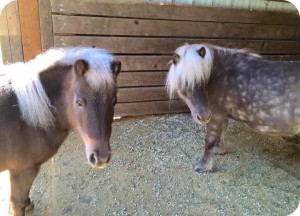Homeopathic Treatment of a Delayed-union fracture in a Miniature Horse by Tara Timpson, DVM
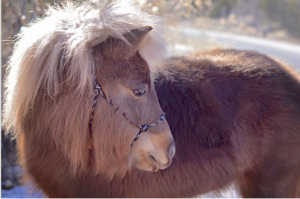 Patient information:
Patient information:
“Missy” 6 year old miniature horse mare
Presenting Problem:
Admitted 7/13/12 with possible non-union or delayed-union spiral fracture of the LH cannon bone (Metatarsal III).
History:
Missy was owned by a family who live in a remote area and survived on a very small fixed income. She fractured her cannon bone while 3 small children were riding her and the saddle slipped. She spooked, the children fell off and she became tangled in the saddle and fell. The family could not afford veterinary care so they placed a full limb plaster cast on Missy and put her in a makeshift sling for 6 weeks. After they removed the cast they noted marked limb laxity and deviation. They approached our rescue group to accept her. They said she was very healthy and had only received 2 doses of NSAIDS (Banamine) while in their care. She never stopped eating and tolerated their makeshift sling amazingly well. She has a large deep scar on the right side of her neck where they said she got stuck in a fence and a wire cable got wedged into her neck. She is a bright mischievous mini who loves to play and is very social and interactive.
[ezcol_1half]
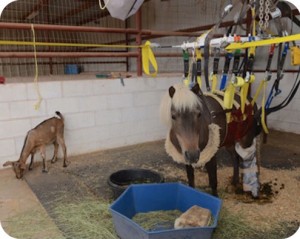
Physical Exam:
On physical exam, Missy was in excellent body condition and overall good health. Her family reported that she was a model patient during her 6 weeks of confinement and even learned how to sit in her sling and “swing” her legs when she was bored. The fractured left hind leg demonstrated marked laxity, and Missy was bearing weight on her fetlock (ankle) joint with her toe pushed forward. Her limb was very loose and wobbly and I suspected this was because she was weight bearing on the fibrous callus.The fracture appeared to affect the biomechanics of the fetlock (ankle) joint as she had limited motion in that joint.
We obtained radiographs of the fracture, and I was amazed at what I saw. Missy had sustained an oblique spiral fracture of the left hind cannon bone with multiple smaller fractures proximally. There was very poor fracture alignment and very minimal callus formation. Missy’s fracture was not only severe, but also considered a “delayed-union” because of the lack of healing callus formation. Additionally, as I suspected, Missy had been weight-bearing on the small amount of fibrous callus that she developed, causing it to become more unstable, creating a snowball effect to further delay callus formation.
Complaint:
Spiral fracture LH Metatarsal III, delayed-union
Homeopathic Work up:
- Is the case well taken? Yes
- Obstacles to cure: none
- Acute/chronic: Acute injury
- Cure/palliation: cure
- Vitality: High
- Miasm: none known, no other clinical signs
- Causation: trauma from a fall
- Never well since fracture
Homeopathic Symptom List:
Fracture, delayed-union LH Metatarsal III
Homeopathic Repertorisation:
Boenninghausen
| Symptom | Rubric: Boenninghausen |
| Fracture, possible non union, xxxxxxx LH Metatarsal III |
1. Bones, fracture, callus deficient |
| empty | 2. Bones, fracture, slow union, slow formation of callus |
Remedies:
Symp, calc-c, lyc, rut, sil, sul
I chose to administer symphytum as the description of the remedy fit nicely. It is an excellent remedy for broken bones with deficient callus formation. It facilitates fracture union and favors production of callus.
Plan:
Symphytum 30 C
7/27/12 Administered Symphytum 30 C.
After consulting with a surgeon about Missy, we both felt the best repair of the fracture would have initially been a surgical one. Unfortunately, the length of time that had passed since the fracture occurred was problematic and could severely complicate healing. We were also concerned about the smaller fractures higher up the cannon bone and how they would create a much more challenging surgical repair. We opted to place a heavy duty splint on Missy and keep her in a sling for another 8-12 weeks to see if better bone healing could be achieved.
Missy was placed in the Anderson sling with a heavy bandage and a lateral splint which was incorporated into the bandage so that she would not be weight bearing on the limb but entirely on the splint. Missy was very comfortable in the sling/splint and had excellent well being. She also had a goat friend to keep her company during her confinement.
Radiographs were repeated in 3 weeks and indicated more substantial and healthy callus formation but not enough to begin weight bearing so she remained in the sling/splint combination and radiographs were repeated 4 weeks later. Callus formation continued to significantly improve and the limb was much more stable. Over the next 5 weeks the splint was gradually adapted to accommodate slow and deliberate weight bearing while she was supported by the sling.
Radiographs at the end of the 5 week period indicated that the fracture was stable enough to allow for weight bearing out of the sling in the adapted splint. The limb remained splinted for an additional 2 weeks after she came out of the sling; however, Missy was so active that the splint began shifting so she was transitioned out of the splint and gradually over the next 4 weeks completely out of a bandage.
We then began the process of gradually strengthening her muscles and tendons and increase her activity level through hand walking. After 4 weeks of preparation she was able transition to a pen with another miniature horse and continued to do well.
The fracture healed completely but because there was not ideal alignment after the initial injury, the limb was shorter than the opposite hind limb and Missy continued to have some reduced range of motion of the fetlock joint and subsequent abnormal loading of tendons and ligaments in the distal limb. Happily, Missy and her buddy Shasta were adopted in November 2013 and she continues to do well in her adoptive home.
[ezcol_1third]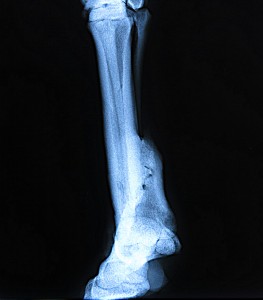 [/ezcol_1third] [ezcol_1third]
[/ezcol_1third] [ezcol_1third]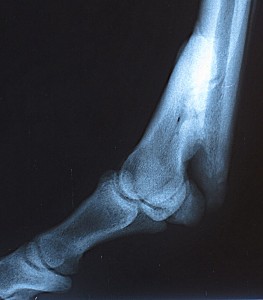 [/ezcol_1third] [ezcol_1third_end]
[/ezcol_1third] [ezcol_1third_end]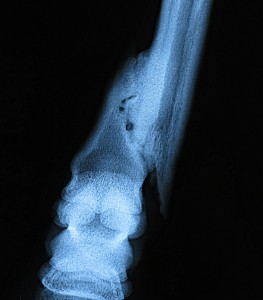 [/ezcol_1third_end]
[/ezcol_1third_end]
Missy’s healed fracture
